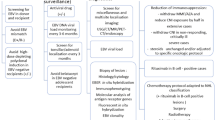Abstract
A patient with both a renal and pancreatic transplantation developed a diffuse large B-cell lymphoma, Epstein-Barr virus-related, 14 months after the surgical procedure. Tumor was confined to the transplanted organs: head of the pancreas and hilar lymph node of the transplanted kidney. Chimerism analysis demonstrated the tumor origin from donor lymphoid cells. Immunosuppression was discontinued and chemotherapy with cyclophosphamide, hydroxydaunomycin, vincristine, and prednisone (CHOP) was started. However, no response was observed after three courses of this regimen. Finally, a transplantectomy was carried out, followed by rituximab (anti-CD20 antibody), with the patient achieving a complete response (CR). Two years later the patient remains in CR.




Similar content being viewed by others
References
Chadburn A, Suciu-Foca N, Cesarman E et al. (1995) Post-transplantation lymphoproliferative disorders arising in solid organ transplant recipients are usually of recipient origin. Am J Pathol 147:1862–1870
Bustillo M, Perez Melon C, Otero Glz A et al. (2000). High grade lymphoma in a post-renal transplant patient. Description of a case and literature review (letter). Nephron 84:189–191
Swinnen LJ (2000) Diagnosis and treatment of transplant-related lymphoma. Ann Oncol 11[Suppl 1]:45–48
The International Non-Hodgkin's Lymphoma Prognostic Factors Project (1993) A predictive model for aggressive non-Hodgkin's lymphoma. N Engl J Med 329:987–994
Ziegle JS, Su Y, Corcoran et al. (1992) Application of automated DNA sizing technology for genotyping microsatellite loci. Genomics 15:1026–1031
Pfeffer PF (1999) Cancer in organ transplanted patients. Tidsskr Nor Laegeforen 119:3792–3794
Penn I (2000) Cancers in renal transplant recipients. Adv Ren Replace Ther 7:147–156
Shapiro RS, McClain K, Frizzera G et al. (1988) Epstein-Barr virus associated B cell lymphoproliferative disorders following bone marrow transplantation. Blood 71:1234–1243
Zutter MM, Martin PJ, Sale GE et al. (1988) Epstein-Barr virus lymphoproliferation after bone marrow transplantation. Blood 72:520–529
Swerdlow SH (1997) Classification of post-transplant lymphoproliferative disorders: from past to present. Semin Diagn Pathol 14 [Suppl 1]:2–7
Gaidano G, Dalla-Favera R (2000) Pathobiology of non-Hodgkin lymphomas. In: Hoffman R, Benz EJ Jr, Shattil SJ et al. (eds) Hematology: basic principles and practice, 3rd edn. Churchill Livingstone, Philadelphia, p 1224
Armitage JM, Kormos RL, Stuart RS et al. (1991) Posttransplant lymphoproliferative disease in thoracic organ transplant patients: 10 years of cyclosporine-based immunosuppression. J Heart Lung Transplant 10:877–886
Cesarman E, Chadburn A, Liu YF et al. (1998) BCL-6 gene mutations in posttransplantation lymphoproliferative disorders predict response to therapy and clinical outcome. Blood 92:2294–2302
Benkerrou M, Jais JP, Leblond V et al. (1998) Anti-B-cell monoclonal antibody treatment of severe posttransplant B-lymphoproliferative disorder: prognostic factors and long-term outcome. Blood 92:3137–3147
Grillo-Lopez AJ, White CA, Varns C et al. (1999) Overview of the clinical development of rituximab: first monoclonal antibody approved for the treatment of lymphoma. Semin Oncol 26 [Suppl 14]:66–73
Schilder R (1999) Rituximab immunotherapy. Cancer Biother Radiopharm 14 [Suppl 4]:237–240
White CA (1999) Rituximab immunotherapy for non Hodgkin's lymphoma. Cancer Biother Radiopharm 14 [Suppl 4]:241–250
Kosits C, Callaghan M (2000) Rituximab: a new monoclonal antibody therapy for non-Hodgkin's lymphoma. Oncol Nurs Form 27 [Suppl 1]:51–59
Milpied N, Vasseur B, Parquet N et al. (2000) Humanized anti-CD20 monoclonal antibody (Rituximab) in post-transplant B-lymphoproliferative disorder: a retrospective analysis on 32 patients. Ann Oncol 11 [Suppl 1]:113–116
Acknowledgments
This paper has been supported in part by a grant provided by "Marathon TV3, 1999", a nonprofit project raising funds for research in medicine, and FIS no. 00/946 from the Spanish Ministry of Health.
Author information
Authors and Affiliations
Corresponding author
Rights and permissions
About this article
Cite this article
Cibeira, M.T., Lopez-Guillermo, A., Colomer, D. et al. Diffuse large B-cell lymphoma arising from donor lymphoid cells after renal and pancreatic transplantation. Ann Hematol 82, 131–135 (2003). https://doi.org/10.1007/s00277-002-0591-z
Received:
Accepted:
Published:
Issue Date:
DOI: https://doi.org/10.1007/s00277-002-0591-z




